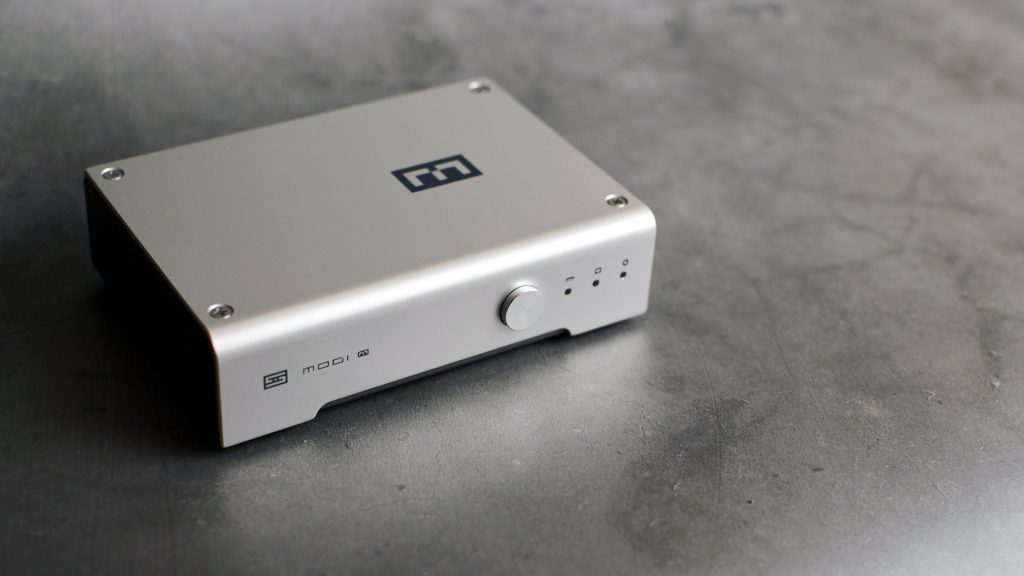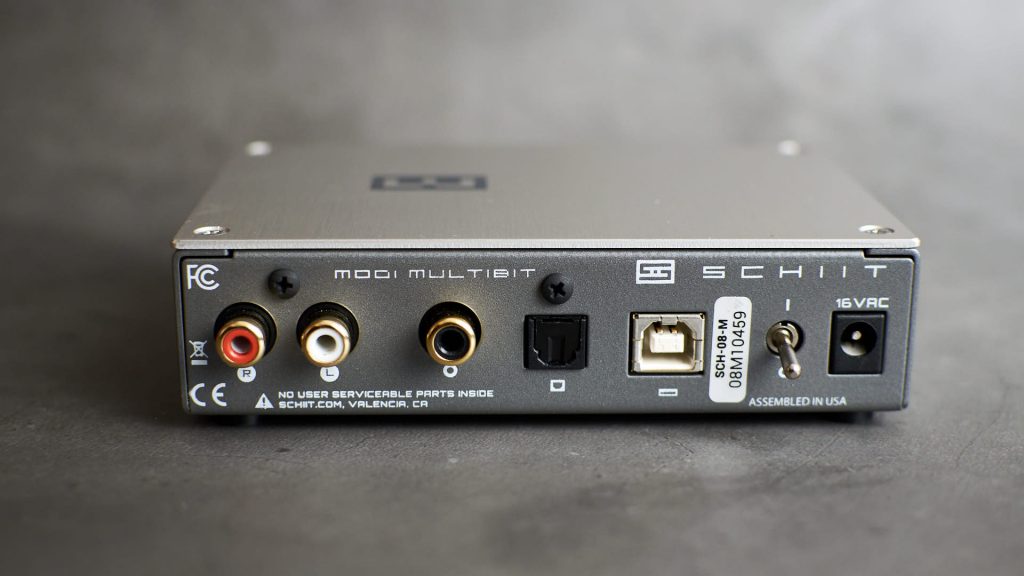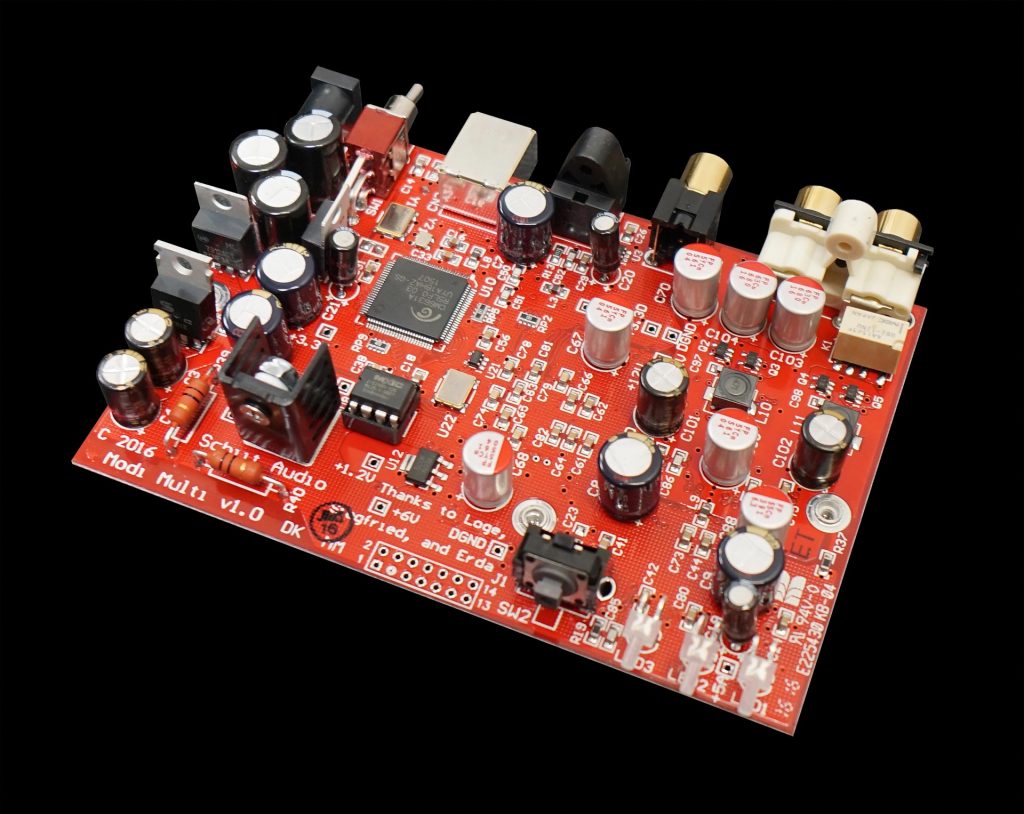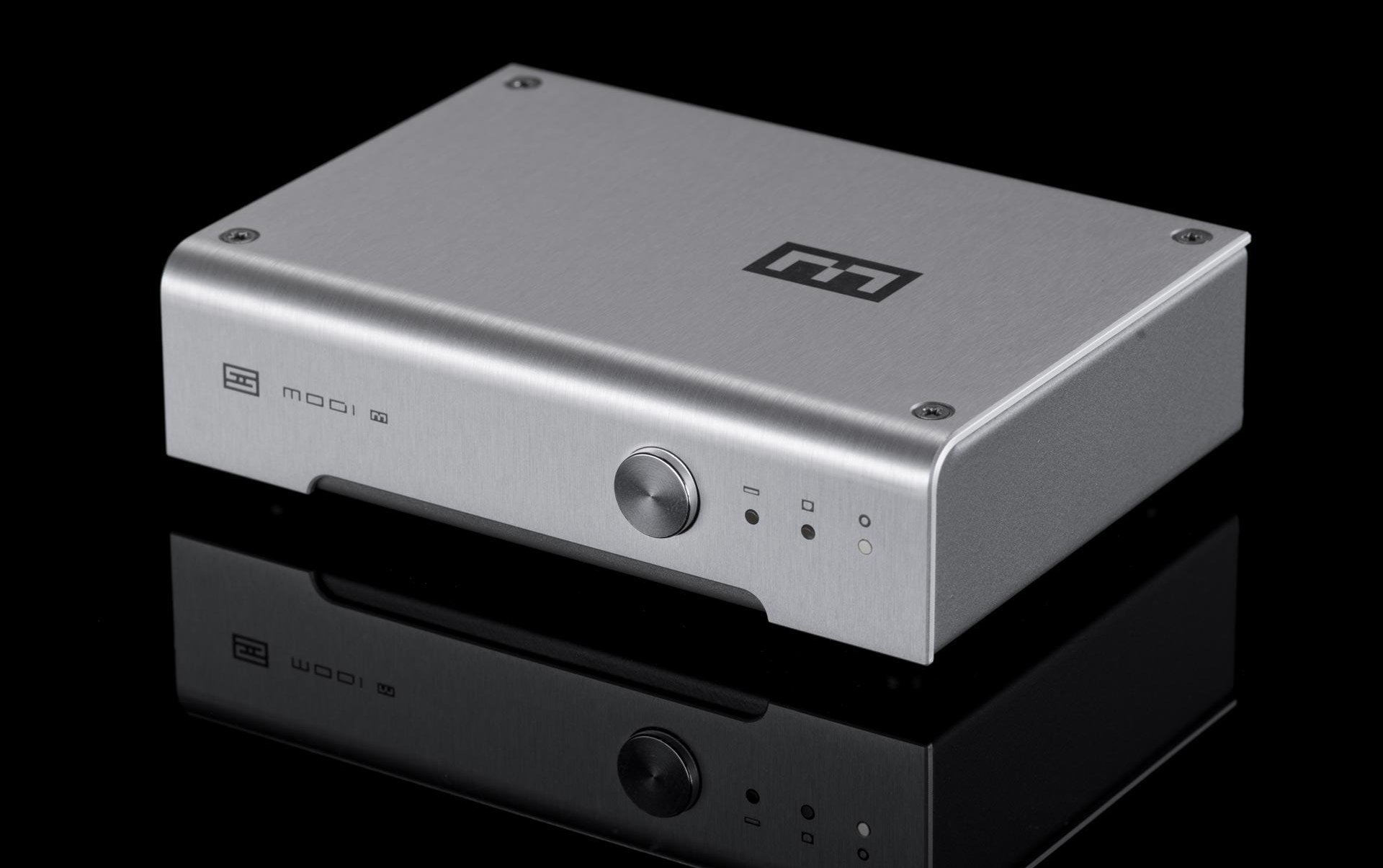For some time now I’ve been wanting to give a try to a multibit DAC and it made sense that the most affordable of them – Schiit Modi Multibit – would be a good starting point.
If you’re new to the whole D/A conversion story, I’ll try and get you through the ropes as quickly as possible, since that’s not really the topic of today’s review. There are two main ways of converting a digital to an analog signal, first one uses multiple voltage levels to represent the signal waveform (multibit) while the other one uses just two levels, 0 V and 5 V, that are switching very fast and then being filtered to recreate waveform (1-bit switching or Delta Sigma). Most modern DAC chips produced by companies such as Sabre and Asahi Kasei are Delta Sigma. Multibit ones are low in numbers, with Burr-Brown still holding the fort with some hybrid solutions. But you can also build a multibit DAC from scratch, not with a chip but by using discrete resistors, which is called R2R method. Unfortunately, that takes much more space, it’s costlier and has its own set of challenges.
Here enters Schiit with a somewhat unique idea. They decided to use an industrial D/A converter of a multi-bit sort, meant for use in precise robotic arms. But to do it they first needed to come up with their own programming that’ll adapt the chip for audio purposes, and they did it. At first, this technology was used only in the more expensive models, but eventually, the company did some trimming and the word’s most affordable fully multibit DAC was born – Modi Multibit.

Build, Features, and connectivity
Size and style of Multibit are basically the same as with the already reviewed Modi 3, but with few changes. First of all, it is clearly heavier which might be due to the included linear power supply inside the chassis. The external wall-wart provided with Multibit is just an AC-AC transformer while conversion to DC is done inside the device itself, and Schiit claims it’s 100% linear power supply in there.
The next difference is that USB port on the back is a full-size USB-B this time, not the micro-USB. I’m a huge fan of this decision since most DACs use big USB-B connectors, they are more sturdy too, and most decent quality USB cables are made that way. Both coaxial and optical S/PDIF connections are provided too, which makes for decent connectivity.
Aside from that, there’s also a power switch in the back and input selector in the front. That’s all, no volume control, no digital filters selection, no headphone out – this is a plain old DAC so let’s find out how well it performs its function.

Older and newer version
Just before we jump into the sound talks, it’s important to say that the current version of Multibit, and the one I have here, is version 2. It doesn’t differ from the original one (pre 2018.) in terms of hardware but in updated programming and signal handling. That said, if you already own an older one, you can’t simply update the firmware via your PC. You’ll have to either send it back to Schiit or to order a memory chip with new firmware preloaded, which will set you back $35, and swap the old memory chip with the new one yourself.
Test
I had put Schiit Modi Multibit in my main setup and right out of the box it sounded quite congested and grainy. Several hours later, things were starting to get better. I let it work for a few more days, checking it occasionally and noticing that somewhere in between 24 and 48 hours it started to sound like a proper DAC. Once that happened I was quite pleased with what I heard.
If you’re like me, coming from a long line of Delta Sigma DACs, the first thing that’ll probably strike you is a full-bodied presentation. The rich and thick midrange is making vocals and all instruments appear weightier and more palpable. Initially, I felt that the higher part of the frequency spectrum is a bit rolled off, but the more I listened the more I realized that everything is there but it’s just presented in a more laid back fashion compared to your typical DAC at this price range. Bass region is simply good, with respectable weight, control, and speed. Nothing really unusual or very specific there.
Talking about sound-stage, it’s as wide as with any good DAC of similar pricing. It’s a bit more interesting though when we talk about layering and dimensionality of each note. These are the things that Schiit Modi Multibit is doing like no other DAC I’ve heard near this price does. Both vocals and instruments convey the sense of having more three-dimensionality, and space between them. This trait is quite intoxicating and once heard it’s difficult not to seek for it in other DACs too. Moreover, due to that full midrange and juicy after-tones, instrument timbre feels really rich and natural. Now add to it resolving but never too aggressive and tacky higher spectrum and we have a recipe for a really pleasurable presentation.


Comparison
At the moment I had two fine Delta Sigma DACs at hand – Topping E30 based on an Asahi Kasei D/A convertor and EarMen TR-Amp based on a Sabre one. Both of these are really good units that I really enjoyed listening to.
To make the playing field even, Topping E30 was used with an external low noise power supply which brings the total cost to ~ $180. EarMen TR-Amp on the other hand has its own battery power supply. Both of these DACs sound really good and very detailed, with TR-Amp being a bit livelier and juicer sounding than E30. However, neither could match the bold and full-bodied rendition of Modi Multibit, nor create the same impression of dimensionality. There’s no sense of beating around the bush here (and I promised never to do that), they both sound great in isolation but flat and thin in comparison to Multibit.
Now, this might as well be a matter of preference, but I also found out that all of my visitors during these last few weeks preferred the way Multibit sounds too.
Conclusion
If you’re interested to dip your toe into the multibit pool and check if you like it or not – Schiit Modi Multibit is the most affordable option on the market right now. I did just that and as you can see it made quite an impression. But just to be clear here, I really don’t care what technology is used as long as the final result is good. In this case, the result is really something and I have yet to hear anything as good at this price point, let alone something better.
So it goes without a question that if you plan on spending around this much on a DAC (even looking at the higher EU price), Schiit Modi Multibit should be very high on your consideration list.
| SCHIIT MODI MULTIBIT – CHARACTERISTICS |
|
D/A converter: Analog Devices AD5547 |






How does it compare to the iFi Zen Dac in terms of sound?
Multibit has fuller midrange, better controlled bassline, and better layering. But Zen is still great 2in1 (DAC and Head-amp) especially for the price.
Right on, thank you very much for that description.
I just acquired the Topping E30 about 2 weeks ago and it sounds wonderful in my stereo setup. I am not much of a headphone listener except with ear buds. The Multibit is twice the price of the E30. When you say “thick” midrange do you mean like a blob of jello/pumpkin thrown on your face or do you mean it “blooms” with refinement like you would get from a tubed system perhaps like a very large dandelion “seed head”? Thanks.
Hi Peter! It’s definitely not the blob/jello-like cause that would mean it’s out of control and slow pace too and I’d never give it this high praise. It’s much more like your tube-like example to my ears, just adding tone richness and boldness.
Thank you for your kind response…I wonder if you will ever do a review on the Topping D90 and compare with its younger brother E30. I am debating whether it is worth the upgrade with additional $550 expense to reach the higher end until a better comes along….Cheers!
^ Peter, d90 is not worth 550$ more. I’m willing to bet the Schiit Modi Multibit would sound more interesting than the d90. If you listen to DS dacs on youtube samples (even highend ones like RME ADI2 and d90), they all sound almost the same and kinda flat. Just get a Chord mojo, Schiit Bifrost 2 or Denafrips Ares 2 for a good sounding dac in that pricerange. Trust me i’ve had many dacs, r2r and fpga is where its at.
Thank you Mike…I will consider your recommendations…cheers!
This is the most thorough review of the Modi Multibit that I have seen. Very helpful.
Thanks!
Glad you like it, Jim, and thank you for the praise.
Nice review. You do a great job making clear reviews.
Do you find the Modi Multibit inputs give different results. I have read over USB it is not as good as over coaxial. Do you hear any difference?
How about optical vs others as well?
Thanks Jim. It’s tough to access those kinds of things since no USB and S/PDIF digital out (and cable) sound the same too. That said, I did have a chance to listen to it connected to both the Allo DigiOne S/PDIF output and Allo USBridge USB out. The second one is higher in Allo’s hierarchy and it should be of higher sound quality too, but Modi Multibit sounded a bit cleaner and more energetic through DigiOne. This might be an indication that Coaxial input is indeed somewhat better. That said, if not compared directly, USB sounds perfectly fine too.
Thank you so much for the very detailed and precise reviews you are providing to us. Just want to ask your thoughts if there are any DACs you could suggest aside from Schiit Modi Multibit in terms of “Layering and Three Dimensionality sound.” Currently i am using SMSL Sanskrit MKII, it has great sound however i’m still craving for that wider soundstage, more expressive and lively sound presentation. Appreciate your help. Thank you in advance & more power.
I haven’t encountered anything at that price range doing those things as good as Modi Multibit. Delta Sigma DACs have many qualities but that full and expressive presentation with a three-dimensional soundstage that Multibit is capable of is something they still can’t do.
Thinking of buying a new Leak CDT transport to replace my old Marantz cd player. In your opinion , would the Shiit multi bit DAC be a good match up with the cd transport playing through a vintage Marantz 2245 receiver ? Looking to produce good cd sound for playback only so I don’t need a DAC with a headphone jack or any other functionality other than digital in and analog out.
Hello, I just buy the modi Schiit multibit. I want to connect to my bluesound node. Can you give me advise of which output I have to use to have the best result. Is there all have the same quality or sound different. Thank you very much. Ps : you make a wonderful video, is very helpful 👏👏👏
Congratulations on your purchase! I would use Coax out.
Thank you !
I have the first version of Mimby and been using since 2017. I’ve recently moved to a new flat and had to re-organise my stereo setup, so that led to some online browsing about my gear. And I happened to stumble onto Audiolab’s destroying test of this unit, which concludes that the humble Modi 3 is better than Mimby by a large margin. Believing I had lived in sin without knowing it for years I run to get my Modi 3 out of some lost drawer and hooked it to the system. And then, after some records I was forced to conclude that while the sound was maybe more “neutral”, it lacked the soundstage, details and body -the joy!- that my good old Mimby had gotten me used to. Bottom line, my infidelity was just a brief moment of hesitation: Mimby is back in my main system and Modi 3 back to its drawer. There are more things in heaven and earth that are dreamt of in your spectrum analyzers…
I have the first version of Mimby and been using since 2017. I’ve recently moved to a new flat and had to re-organise my stereo setup, so that led to some online browsing about my gear. And I happened to stumble onto AudioScience’s destroying test of this unit, which concludes that the humble Modi 3 is better than Mimby by a large margin. Believing I had lived in sin without knowing it for years I run to get my Modi 3 out of some lost drawer and hooked it to the system. And then, after some records I was forced to conclude that while the sound was maybe more “neutral”, it lacked the soundstage, details and body -the joy!- that my good old Mimby had gotten me used to. Bottom line, my infidelity was just a brief moment of hesitation: Mimby is back in my main system and Modi 3 back to its drawer. There are more things in heaven and earth that are dreamt of in your spectrum analyzers…
Great post. 👍 I would also never change Mimby for Modi.